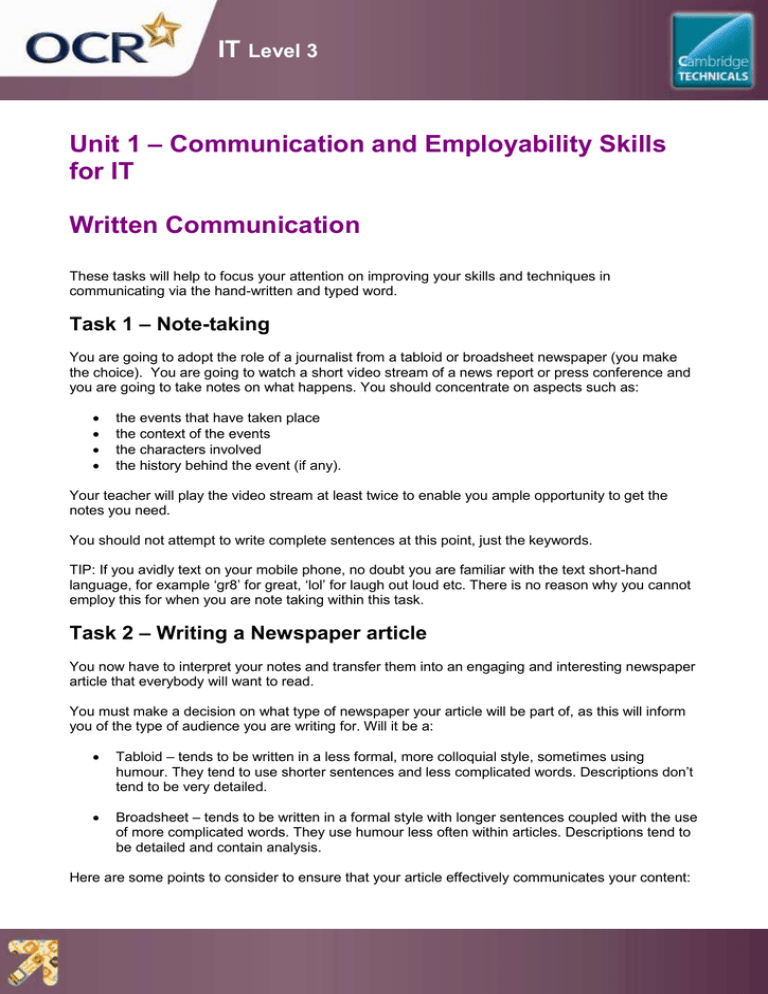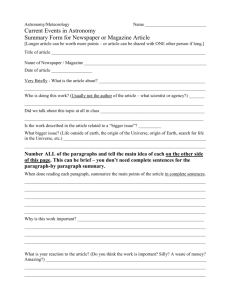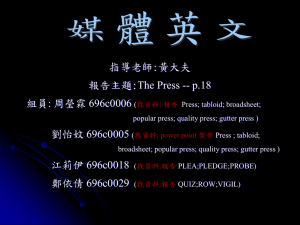Unit 01 - Written communication - Lesson element learner task (DOC, 260KB)
advertisement

IT Level 3 Unit 1 – Communication and Employability Skills for IT Written Communication These tasks will help to focus your attention on improving your skills and techniques in communicating via the hand-written and typed word. Task 1 – Note-taking You are going to adopt the role of a journalist from a tabloid or broadsheet newspaper (you make the choice). You are going to watch a short video stream of a news report or press conference and you are going to take notes on what happens. You should concentrate on aspects such as: the events that have taken place the context of the events the characters involved the history behind the event (if any). Your teacher will play the video stream at least twice to enable you ample opportunity to get the notes you need. You should not attempt to write complete sentences at this point, just the keywords. TIP: If you avidly text on your mobile phone, no doubt you are familiar with the text short-hand language, for example ‘gr8’ for great, ‘lol’ for laugh out loud etc. There is no reason why you cannot employ this for when you are note taking within this task. Task 2 – Writing a Newspaper article You now have to interpret your notes and transfer them into an engaging and interesting newspaper article that everybody will want to read. You must make a decision on what type of newspaper your article will be part of, as this will inform you of the type of audience you are writing for. Will it be a: Tabloid – tends to be written in a less formal, more colloquial style, sometimes using humour. They tend to use shorter sentences and less complicated words. Descriptions don’t tend to be very detailed. Broadsheet – tends to be written in a formal style with longer sentences coupled with the use of more complicated words. They use humour less often within articles. Descriptions tend to be detailed and contain analysis. Here are some points to consider to ensure that your article effectively communicates your content: IT Level 3 When you are writing the first paragraph, within the first few sentences, you need to answer these questions: Who? What? When? Where? Why? You need to grab the reader's attention by using an opening sentence that is a question or something unexpected. After the first paragraph, give the details. It is always a good idea to include one or two quotes from people you interviewed. Always write in the third person (he, she, it or they) and always be objective. Use active verbs so the reader feels things are really happening. In the last paragraph you need to round off your article. You could try ending your piece with a quote or a catchy phrase. At the end of the article always include a ‘by-line’, which is a line stating who wrote the article – in this case you, i.e.: 'By ....'. Proof-read your article and edit where needed. Spell check your article! Send your article to your editor (teacher) These activities offer an opportunity for English skills development.


